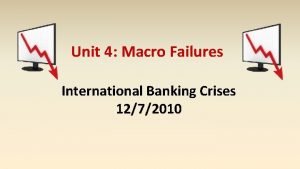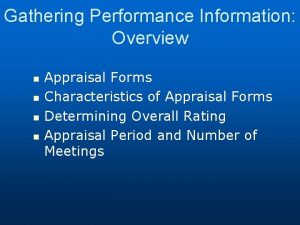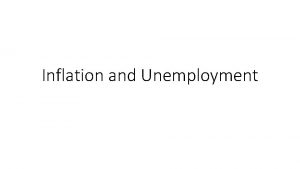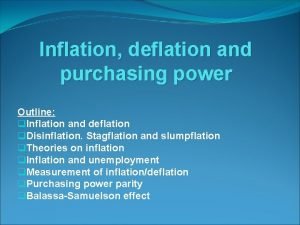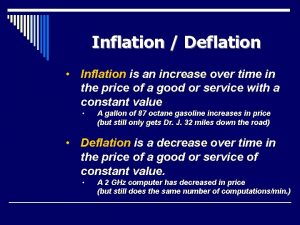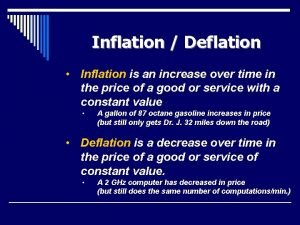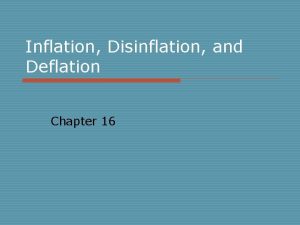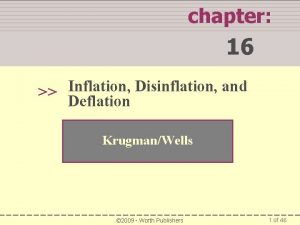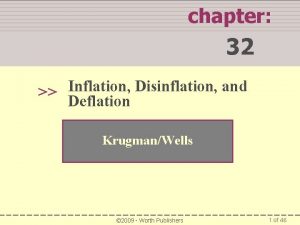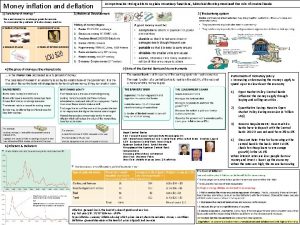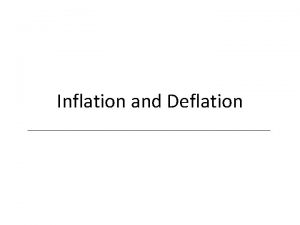Weak inflation and threat of deflation Inflation Very



























- Slides: 27


Weak inflation and threat of deflation • Inflation Very Low Throughout Euro Area


Weak inflation below ECB target • The rates of inflation (measured by HICP) in the individual member states of the euro area vary greatly from -1. 6 percent (Cyprus) to 1. 9 percent (Finland). In January 2014 inflation in Germany was at 1. 2 percent, slightly higher than the euro area average. • Greece (-1. 4 percent) and Cyprus are the only member states experiencing deflation, though inflation is at a historic low in all the other crisis countries (Spain: 0. 3 percent, Italy: 0. 6 percent, Ireland: 0. 3 percent, Portugal: 0. 1 percent)

Inflation expectations • inflation expectations in the euro area have declined significantly in 201214 • Only long-term inflation expectations over the next ten years are, at 1. 8 percent, in line with the ECB’s definition of price stability. • However, not so much credence should be placed on long-term inflation expectations. • First, it is the short and medium-term expectations that are key for actual price and wage developments. • Second, the case of Japan demonstrates that a country can still slide into deflation despite long-term inflation expectations being firmly anchored at a high level.


Savings, debt burden output gap • Despite the historically low interest rates, the savings rates of households in large parts of the euro area are currently relatively stable and even on the increase. • Instead of taking advantage of the low interest rates to bring about higher consumer and investment spending, the private sector is particularly focused on alleviating its debt burden. • Combined with the large negative output gap in the euro area as a whole and in the individual member states this is having a dampening effect on price growth.

Saving rate

Output gap

Debt reduction

Monetary growth • Monetary and credit development in the euro area has also been weak and shows no signs of an imminent inflationary trend anytime soon.


Aggregate balance sheet of the banking sector

Lending fell sharply

Decline in Lending • The decline in the balance sheet total on the assets side was primarily due to downturn in lending to businesses located in the euro area, and especially a reduction in interbank loans and loans to non-financial companies. A comparison of the economically most important member states shows that the decline in lending to non-financial companies was particularly pronounced in Spain and Italy, whereas in Germany and France this dip was much less significant • In Spain and Italy the average loan interest rates for non-financial companies, continue to differ substantially (currently by over 1. 3 percent) from interest rates in the rest of the euro area. In December 2013, for instance, interest rates for medium and long-term loans to non-financial companies in Germany were, on average, approximately 2. 8 percent, while in Spain and Italy, they were around 80 and 65 basis points higher(that is o, 8% -0. 65% higher) •

Loan interest rates

Explanation: from boom to bust • Prior to the crisis, the current crisis countries saw the price competitiveness of for example Spain and Italy decline relative to countries such as Germany and the Netherlands. • While unit labor costs in Germany only increased slightly and even fell due to productivity gains and wage restraints, productivity growth in Spain and Italy continued to lag behind the consistently strong wage increases. • Moreover, favorable credit and refinancing conditions allowed massive debt levels to develop, both in the private and the public sectors. • These undesirable developments now have to be rectified. • For price competitiveness to be restored in the crisis countries, there must be a sufficiently strong drop in prices and wages and the excessive debt must be reduced. • These developments are necessarily linked to low spending and high savings rates which counteract an increase in general pricing levels

Deflation risk • The Central Bank mandate of price stability refers not only to countering rising prices but also to preventing a general price decline. • Typically, a central bank counteracts inflationary developments by raising interest rates and deflationary developments by cutting interest rates. • However, if it has lowered its interest rates to almost zero, it can no longer stop continued price declines solely using an interest rate policy. A central bank will then only have unconventional measures at its disposal to raise prices and/or inflation expectations.

Deflation and spending –saving behaviour • A key determinant of the spending and saving behavior of households and companies is the (long-term) real interest rates. • If a deflationary development and therefore a rise in real interest rates is expected, household and business investment and consumer spending decrease in favor of saving. • This, in turn, leads to a downward pressure on prices of goods and real assets (precious metal, real estate etc) and can therefore cause a downward price spiral and a recession; • the Central Bank is only able to break this spiral using conventional means as long as it has not yet reached an interest rate of zero.

Deflation and debt burden • Deflation represents an acute threat to financial stability since debt problems, financial crises, and deflation may reinforce one other • deflation increases the real burden of debt on borrowers and debtors and thus compounds the risk of them running into financial hardship. • debt problems reinforce deflationary tendencies. Why? • Borrowers try to lower real debt burdens, which are rising due to deflation, by distress-selling assets in order to service their debts with the proceeds. As long as debtors have a higher spending tendency than their creditors, this process will, on aggregate, lead to a contraction of overall economic demand a further fall in prices

Debt burden and deflation • Distress sales also exert downward pressure on asset prices, which not only results in (higher) losses for business entities that rely on these sales to service their debts, but also leads to losses for owners with similar portfolios not yet in financial hardship. • Large portion of the losses from bankruptcies caused by deflation has burdened the financial and banking sector; this hinders the financial intermediation process. • The consequences are a significant deterioration in the financial conditions of the real economy and a credit crunch. They also reduce consumption and investment spending and reinforce the initial deflationary development

ECB forward guidance • The ECB has introduced an important new change to its communication strategy. • In July 2013, it announced that it would be keeping its base rates at a low level for an extended period of time. This is the first time that the ECB has made a statement about the future direction of its monetary policy (forward guidance). • In contrast to the US Central Bank (Federal Reserve Bank), however, the ECB is using a much weaker form of forward guidance; it specifies no explicit quantitative upper or lower threshold values outside of which interest rate increases would be necessary

Forward guidance • The purpose of forward guidance is to steer the expectations of market participants with regard to future monetary policy decisions. • Forward guidance can play an important role precisely as the base rates approach zero. • According to the expectation hypothesis of the term structure of interest rates, the long-term interest rate will be the same as the average anticipated short-term interest rate in the future. • The announcement by the Central Bank that it would keep the base rate at a low level for an extended period therefore resulted in downward pressure on longer-term interest rates without actually having to reduce the base rate; given the zero interest rate, this would hardly have been possible anyway.

Central banks intervention: QE

Transmission channels of QE • Signaling channel: Purchases of longer-term bonds signal that the Central Bank will keep its interest rates down over a longer period of time. If it holds assets with longer terms and higher durations, it will suffer a loss on these assets as a result of the interest rate increase. Since the Central Bank usually aims to avoid such losses, buying longer-term bonds indicates that interest rates will remain low for a longer period of time. As a result, this should reduce the interest on all securities. • Portfolio balance channel: By buying (longer-term) securities, the Central Bank increases their price. As long as the reserves given a cash injection from the purchases do not represent a perfect substitute for the securities acquired, the seller will want to invest in other asset forms which, in turn, increases the prices of these securities. This process continues until, on aggregate, the economic operators are ready to hold the total amount of Central Bank money made available and the assets on the market. Furthermore, the purchases reduce the risk of interest rate changes that holders of longer-term securities face. Consequently, their returns fall and returns on short-term securities rise.

Transmission channels QE • Liquidity channel: Since the amount of Central Bank money is increased by purchasing securities and Central Bank money is the most liquid asset, liquidity premiums on assets that would otherwise be particularly in demand due to their liquidity, fall. • Credit channel: The additional liquidity made available by the Central Bank makes it easier for banks to refinance loans to the real economy and should lead to an increased supply of credit and/or better refinancing terms for the real economy.

ECB programs effects • The ECB’s first covered bonds program, as well as its purchases of government bonds, also achieved a significant impact. While the CBPP lowered longer-term money market rates and was able to improve market liquidity in important segments of the financial market long term, the government bond purchases had a significantly negative impact on returns in secondary markets.
 Weak acid and weak base reaction
Weak acid and weak base reaction Strong acids
Strong acids Strong acid weak base titration graph
Strong acid weak base titration graph Wielandt deflation
Wielandt deflation Deflation
Deflation Deflation
Deflation Deflation
Deflation Martin anzengruber
Martin anzengruber What is deflation
What is deflation What is deflation
What is deflation English school grades system
English school grades system 9 major components of appraisal forms
9 major components of appraisal forms Types of unemployments
Types of unemployments Very bad to very good scale
Very bad to very good scale Used to express very large or very small numbers
Used to express very large or very small numbers Few fewfewf
Few fewfewf It is a very shallow skillet with very short sloping sides
It is a very shallow skillet with very short sloping sides Quantifiers of food
Quantifiers of food For parents and friends radiation threat
For parents and friends radiation threat List of opportunities and threats of a student
List of opportunities and threats of a student Suspicious packages training
Suspicious packages training Distinguish among vulnerability threat and control
Distinguish among vulnerability threat and control Threat and hazard identification
Threat and hazard identification Weak forms examples
Weak forms examples Syllables in strong
Syllables in strong Difference between strong and weak semaphore in os
Difference between strong and weak semaphore in os Ph 3 acid or base
Ph 3 acid or base Weak acid and conjugate base
Weak acid and conjugate base








